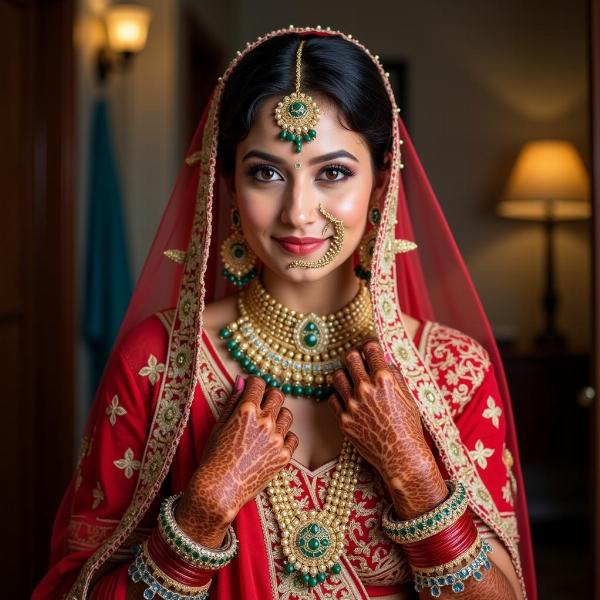Alankarit meaning in Hindi revolves around the concept of ornamentation, decoration, and embellishment. Understanding the nuances of this word opens a window into the rich tapestry of Indian culture, where adornment plays a significant role in everything from personal attire to religious rituals. Whether you’re exploring Hindi literature, deciphering traditional practices, or simply expanding your vocabulary, grasping the true essence of “alankrit” is crucial.
Exploring the Multifaceted Meanings of Alankarit
Alankarit (अलंकृत) is derived from the Sanskrit word “alankara,” which signifies ornament or decoration. In Hindi, “alankrit” functions as an adjective, describing something that is adorned, decorated, or embellished. It can refer to physical objects, such as a beautifully decorated house or an intricately carved statue, as well as abstract concepts like embellished language or a story adorned with metaphors and similes. The word evokes a sense of beauty, richness, and elaborateness.
Alankarit in Everyday Life
From the colorful bangles adorning a woman’s wrists to the ornate rangoli patterns gracing the entrance of a home, “alankrit” manifests itself in various aspects of daily life in India. Traditional Indian clothing, often richly embroidered and embellished with sequins and beads, exemplifies the concept of “alankrit.” Festive occasions, like Diwali and Holi, see homes and streets transformed into vibrant displays of decoration, further highlighting the significance of adornment in Indian culture.
Alankarit in Literature and Arts
In Hindi literature, “alankrit” describes a style of writing that is rich in figurative language, ornate descriptions, and elaborate metaphors. Classical poetry, in particular, is often characterized by its “alankrit” style. Similarly, in the visual arts, the term can refer to intricate carvings, detailed paintings, and other forms of artistic embellishment. Think of the detailed miniature paintings of the Mughal era or the intricate carvings found on temple walls. These art forms showcase the meticulous craftsmanship and attention to detail that are integral to the concept of “alankrit.”
 A Beautifully Adorned Indian Bride
A Beautifully Adorned Indian Bride
Understanding the Nuances: Alankarit vs. Sajawat
While both “alankrit” and “sajawat” relate to decoration, there’s a subtle difference. “Sajawat” generally refers to simple decoration or arrangement, whereas “alankrit” implies a more elaborate and ornate form of embellishment. Think of “sajawat” as arranging flowers in a vase, while “alankrit” would be creating an intricate floral arrangement for a grand occasion. This distinction adds another layer of meaning to the term.
Alankarit in Different Contexts
The meaning of “alankrit” can vary slightly depending on the context. For example, in a religious context, it might refer to the elaborate decorations used in temples or during religious ceremonies. In a literary context, it can describe the ornate language used in poetry or prose. Understanding these contextual nuances is essential for a comprehensive understanding of the word.
How to Use Alankarit in a Sentence
Here are some examples of how to use “alankrit” in a sentence:
- “The bride was alankrit in beautiful jewelry.” (दुल्हन सुंदर गहनों से अलंकृत थी।)
- “The temple was alankrit with colorful lights and flowers.” (मंदिर रंगीन रोशनी और फूलों से अलंकृत था।)
- “His language was alankrit with metaphors and similes.” (उनकी भाषा रूपकों और उपमाओं से अलंकृत थी।)
Conclusion: Embracing the Beauty of Alankarit
“Alankarit,” meaning adorned or decorated in Hindi, represents more than just the physical act of embellishment. It embodies a cultural appreciation for beauty, intricacy, and the art of ornamentation. From everyday life to literature and art, “alankrit” permeates various aspects of Indian culture, adding a touch of richness and elegance. Understanding this word provides a deeper insight into the values and aesthetics that shape Indian traditions.
FAQ:
- What is the opposite of alankrit in Hindi? Words like “saada” (simple) or “bina sajaawat ka” (undecorated) can be considered opposites.
- Can alankrit be used to describe a person’s character? While less common, it can be used metaphorically to describe someone with a rich and complex personality.
- Is alankrit a formal or informal word? It can be used in both formal and informal contexts.
- What are some synonyms for alankrit in Hindi? Synonyms include “susajjit” (well-decorated), “sanwarit” (adorned), and “shubhshobhit” (beautifully decorated).
- What is the root word of alankrit? The root word is “alankara” (अलंकार), meaning ornament or decoration.
Meaning-Hindi.in is your trusted partner for all your Hindi translation needs. We offer a comprehensive range of translation services, from business and legal documents to website localization and educational materials. Our expert team ensures accurate and culturally sensitive translations, tailored to your specific requirements. Contact us today at [email protected] or call us at +91 11-4502-7584. Meaning-Hindi.in is committed to delivering high-quality translations that bridge language barriers and connect cultures.